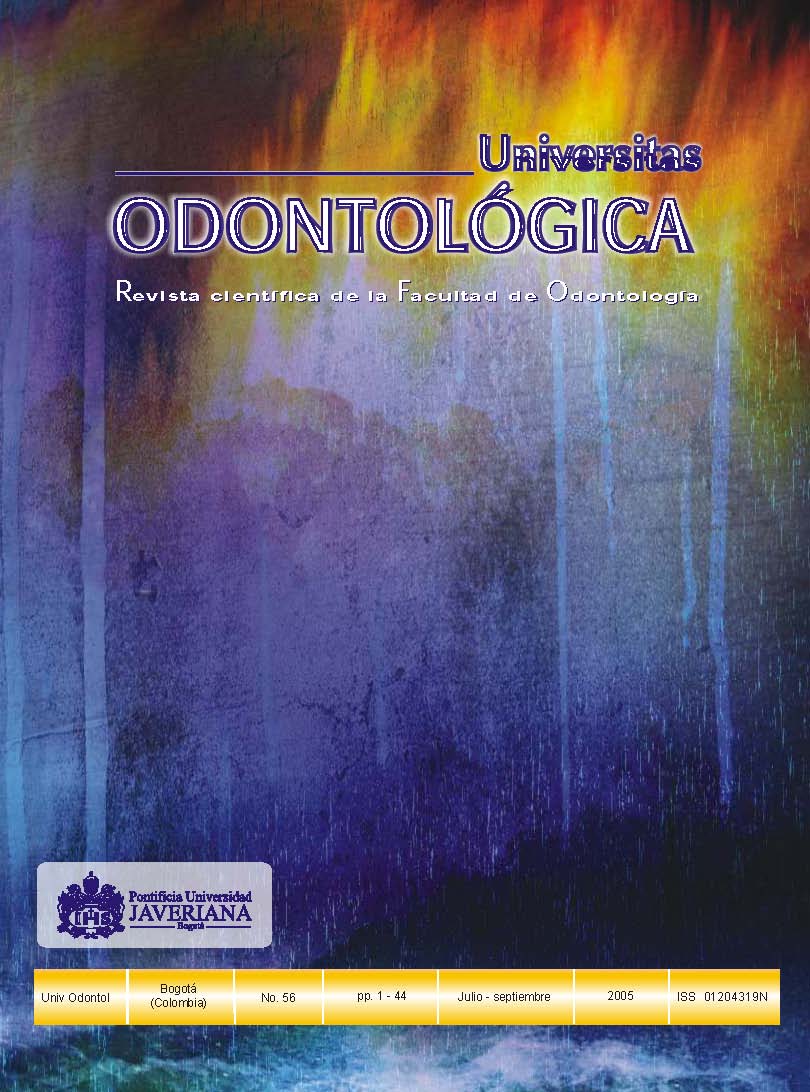Resumo
ANTECEDENTES: el Nitinol superelástico ha sido la aleación de elección utilizada en los alambres de uso ortodóntico en la primera fase del tratamiento. A pesar de sus óptimas cualidades, ese alambre es de uso limitado, por su alto costo, lo cual ha conllevado a que los ortodoncistas se vean motivados a reciclarlo con el fin de compensar su costo en la práctica clínica. OBJETIVO: reconocer las alteraciones de las propiedades mecánicas, de rigidez y superelasticidad de los alambres níquel titanio reutilizados y así regular ésta práctica en la clínica. METODOS: tipo de diseño experimental donde se utilizaron 56 alambres de Nitinol 0.016" 3M Unitek que fueron distribuídos aleatoriamente en grupos de esterilización (glutaraldehído y calor seco). Inicialmente se evaluó la rigidez en su condición original (T0) por medio de la prueba flexión y tensión y posteriormente fueron sometidos a cuatro ciclos de reciclaje. El análisis de los resultados fué fué realizado con la prueba t de Bonferroni (P>0.005)y el ANOVA de dos vías (p>0.05).RESULTADOS:durante la esterilización con frío se observó una tendencia al aumento del valor de rigidez , mientras lo contrario fué evidente al esterilizar con calor seco. La superelasticidad mostró en ambos grupos de esterilización una tendencia al aumento hasta T3. CONCLUSIONES: clínicamente no hay efectos significativos de la esterilización sobre los alambres.
BACKGROUND:Nitinol superelastic wires have been the primary allegiance used in orthodontic wires during the fist phase of treatment. Despite its qualities, these wires are of limited use because of it´s high cost, which has motivated orthondontic professionals to sterilize the material with the purpose of reducing the cost of daily practice. OBJECTIVE: recognize the alterations of the biochemical properties of stiffness and super elasticity of reused nickel-titanium wires and therefore regulate this practice in the clinical enviroment.
Andreasen GF, Morrow RE. Laboratory and clinical analyses of nitinol wire. Am J Orthod 1978; 73: 142-51.
López I, Goldberg J, Burstone CJ. Bending characteristics of nitinol wires. Am J Orthod 1979; 75(5): 569-75.
Drake S, Wayne D, Powers J, Asgar K. Mechanical properties of orthodontic wires in tension, bending, an torsion. Am JOrthod Sept 1982; 3: 206-10.
Kapila S, Sachdeva R. Mechanical properties and clinical applications of orthodontic wires. Am J Orthod Dentofac Orthop 1989; 96: 100-9.
Buckthal JE, Mayhew MJ, Kusy RP, Crawford JJ. Survey of sterilization and disinfection procedures. J Clin Orthod 1986; 20: 759-65.
Buckthall JE, Kusy RP. Effects of cold disinfectants on the mechanical properties and surface topography ofnickeltitanium arch wires. Am J Orthod Dentofac-Orthop 1988;94: 117-22.
Mayhew MJ, Kusy RP. Effect of sterilization on the mechanical properties and surface topography of nickel-titanium arch wires. Am J Orthod Dentofac-Orthop 1988; 93(3): 232-6.
Kapila S, Reichhold G, Anderson S, Watanabe L. Effects of clinical recycling on mechanical properties of nickeltitanium alloy wires. Am J Orthod Dentofac-Orthop 1991;100: 428-35.
Kapila S, Haugen J, Watabe L. Load-deflection characteristics of niquel-titanium alloy wire after clinical recycling and dry heat sterilization. Am J Orthod Dentofac Orthop 1992; 102:120-6.
Miura F, Mogi M, Okamoto Y. New application of superelastic NiTi rectangular wire. J Clin Orthod 1990; 24:544-8.
Waters NE. Superelastic nickel-titanium wires. Br J Orthod 1992; 19: 319-22.
Crawford JJ. State of the art: practical infection control in dentistry. J Am Dent Assoc 1985; 110: 629-33.
Sánches Y, Quiceno L, Aceveco MM. Manual de asepsia y bioseguridad de odontología. Departamento de Recursos Humanos del Instituto de Seguros Sociales, 1995.
Segner D, Ibe D. Superelastic materials displaying different force levels within one archwire. J Orofac Orthop 1998;59: 29-38.
Meling T; Odegaard J. The effect of temperature in the elastic responses to longitudinal torsion of rectangular nickel titanium arch wires. Angel orthodontist 1998; 4: 357-68.
Miura F, Mogi M, Ohura Y, Hamanaka H. The super-elastic properties of the Japanese NiTi alloy wire of use in orthodontics. AJODO 1986; 90: 1-10.
Staggers JA, Margeson D. The effects of sterilization on the tensile strength of orthodontic wires. Angle Orthod 1993;2: 141-4.
Smith G, Fraunhofer VY, Cassey G. The effects of clinical sterilization on selected orthodontic arch wires, AJODO 1992; 102: 153-9.
Tonner RI, Waters NE. The characteristics of superelastic Ni-Ti wires in tree - point bending. Part I: The effect of temperature. Eur J Orthod 1994; 16: 409-19.
Segner D, Ibe D. Properties of superelastic wires and their relevancy to orthodontic treatment. Eur J Orthod 1995; 17:395-402.
Este periódico científico está registrado sob a licença Creative Commons Atribuição 4.0 Internacional. Portanto, este trabalho pode ser reproduzido, distribuído e comunicado publicamente em formato digital, desde que os autores e a Pontifícia Universidade Javeriana sejam reconhecidos. Citar, adaptar, transformar, autoarquivar, republicar e criar novas obras a partir do material é permitido para qualquer finalidade (mesmo comercial), desde que a autoria seja devidamente reconhecida, um link para o trabalho original seja fornecido e quaisquer alterações sejam indicadas. A Pontifícia Universidade Javeriana não detém os direitos sobre os trabalhos publicados, e o conteúdo é de exclusiva responsabilidade dos autores, que mantêm seus direitos morais, intelectuais, de privacidade e de publicidade.


